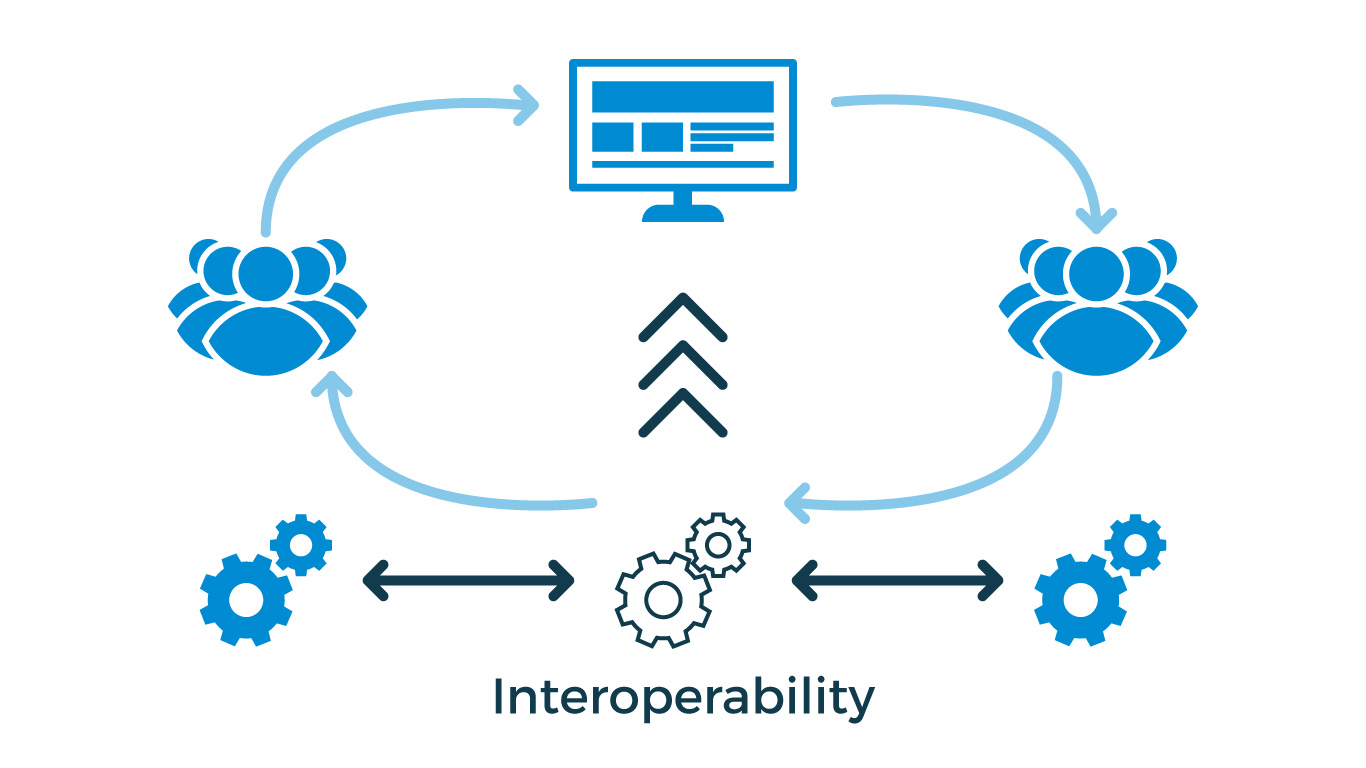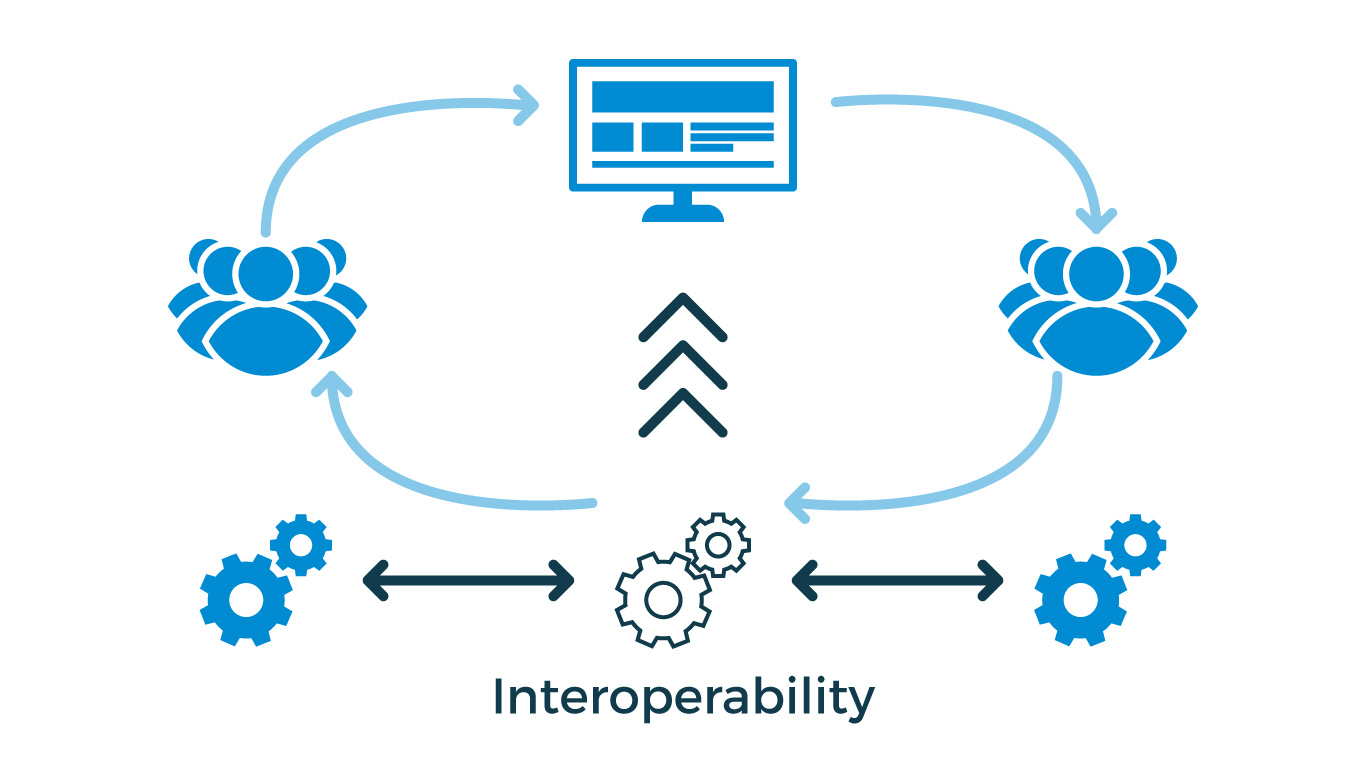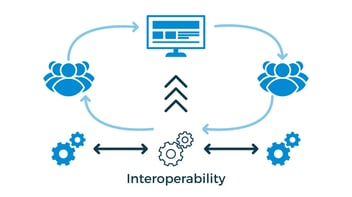What are the different types of enterprise interoperability? Discover the keys to building an efficient interoperability framework.
In today's complex business landscape, companies are compelled to operate with a multitude of systems to manage their processes. As business needs increase, the programs and applications to address these needs also multiply. At this point, different types of business interoperability are not just an advantage but a necessity.

As companies grow, their operations expand, leading to an increase in tasks, personnel, and transactions. This growth demands the acquisition of new systems to handle business operations. However, the real challenge arises when these systems are not interconnected and cannot effectively share data. In this context, business interoperability carries increasing weight and influence on a company's performance.
On the other hand, organizations handle increasingly extensive volumes of data stored in a variety of applications and systems. This diversity can pose problems since each system has its own way of storing and managing data.
Furthermore, these systems store data in heterogeneous formats, making the information practically incomparable. Companies face the situation of having multiple systems, each with disparate data and different structures. Diversity in data formats creates a communication gap within the corporation, resembling a situation where a group of people is trying to have a conversation, but each one speaks a different language. When business interoperability is not efficient, different departments within a company may encounter data access barriers, hindering the exchange of information and affecting the utilization of generated business intelligence.
Lack of effective communication leads to issues in consolidating information, managing master data, connecting applications, and sharing information with third parties. Disparities in exchange formats, naming conventions, and other data requirements need an intermediary to facilitate communication between these systems.
In summary, interoperability has become crucial in the modern business world. Without it, companies face significant obstacles in managing their data and operations. The ability to make diverse systems communicate with each other is essential to ensure efficient and seamless information flow in any organization.
What is interoperability?
Interoperability is defined as the ability of systems, equipment, or entities to exchange information and use it in a mutually useful way, without restrictions on access or implementation. In other words, interoperability refers to the ability of different systems, both internal and external to the organization, to work together, share data, and use information efficiently.
Interoperability is essential in various fields, including information technology, healthcare systems, transportation, and communications, as it facilitates collaboration and the integration of different components and systems to achieve common goals.
Interoperability stands as the technological foundation that unifies all the systems and applications of a business. It is linked to data integration and enables the free flow of data across various platforms, transforming business practices. It facilitates collaboration between departments, ensuring that everyone shares information and works in harmony. Essentially, it acts as a skillful translator that integrates information, making it accessible, understandable, and valuable in its entirety.
Furthermore, interoperability processes reduce redundant tasks and optimize operations by eliminating the need to manually transfer information between systems, thus eliminating unnecessary interruptions. Ultimately, interoperability is also essential for freeing up time and speeding up processes, allowing teams to focus on genuinely productive activities.
Moreover, interoperability becomes an essential resource for managing master data, sharing information with third parties, and consolidating data effectively.
Types of enterprise interoperability
To achieve complete business interoperability, it is essential to address three key aspects:
-
Technical Interoperability: Technical interoperability focuses on the systems' ability to share information within the business context. This involves standardization and resolving potential technical issues that may arise between systems and IT services. It is fundamental for data integration and depends on connection services, middleware, and security. This type of interoperability ensures that all members of a company can easily access the organization's platforms and systems, facilitating secure and agile information exchange.
-
Legal Interoperability: Legal interoperability relates to the socio-economic value of information technologies (IT). To maximize this value, regulatory entities must instill confidence in businesses and developers through open standards and platforms. With the constant increase in international laws and regulations, complying with them becomes increasingly complex for organizations. Adopting cloud service providers offers significant advantages, as these providers, with their expertise and scale, can manage legal interoperability according to current international standards, relieving companies of this burden.
-
Business Interoperability: Business interoperability refers to a company's ability to exchange information with customers, suppliers, external partners, and other service providers. It involves the effective flow of data between the company and other entities, essential for establishing external connections and collaborations. In this context, interoperability is understood as a complex network of interactions, from collaborating with external partners to the optimal level where information exchange does not entail significant costs. However, reaching this level of interoperability does not always indicate optimization; its effectiveness depends on harmonious integration with the company's specific circumstances. Smart interconnection between interoperability and the business environment's conditions is key to achieving seamless and efficient collaboration.
Interoperability standards for businesses
Beyond the three types of interoperability that enterprises should be aware of, interoperability processes involve a number of norms and standards that cannot be ignored and that, in addition to enabling a seamless flow of information, also promote enterprise data quality and data governance.
The interoperability norms and standards that a company must comply with may vary depending on the industry and the type of systems it uses. Below are some common interoperability standards that enterprises may consider, depending on their specific needs:
-
XML (eXtensible Markup Language):
- XML is a widely used standard for the exchange of structured data between different systems. It is versatile and can be adapted to various business needs.
-
JSON (JavaScript Object Notation):
- Similar to XML, JSON is a lightweight data interchange format commonly used in web applications and web services.
-
RESTful API (Representational State Transfer):
- RESTful is a network architectural style for distributed systems, such as web services. It uses HTTP for GET, POST, PUT and DELETE requests, which facilitates interoperability between web systems.
-
SOAP (Simple Object Access Protocol):
- SOAP is a standard protocol for the exchange of structured information in the implementation of web services. It defines a common structure for messages and is based on XML.
-
HL7 (Health Level Seven):
- HL7 is a standard used in the health field for the exchange of information between health information systems, such as electronic health records and hospital information systems.
-
FHIR (Fast Healthcare Interoperability Resources):
- FHIR is a modern HL7 standard designed to improve interoperability in the healthcare sector. It is resource-based and uses data formats such as XML or JSON.
-
EDIFACT (Electronic Data Interchange for Administration, Commerce, and Transport):
- EDIFACT is an international standard for the electronic exchange of business documents, such as orders and invoices, used in international trade.
-
OData (Open Data Protocol):
- OData is a data access protocol that enables interoperability between different data systems, providing a common standard for queries and data manipulation.
-
PCI DSS (Payment Card Industry Data Security Standard):
- PCI DSS is a security standard for payment card transactions. Although it does not focus specifically on interoperability, it is crucial for companies handling credit and debit card data.
It is important for companies to assess their specific needs and the standards relevant to their industry. In addition, they should consider local, regional and global regulations and standards that may affect the interoperability standards with which they must comply. The choice of appropriate standards will depend on the context and the systems with which the company needs to interoperate.
Conclusion
In an increasingly interconnected and dynamic business world, interoperability has become a fundamental cornerstone for organizational success. In this article, we have explored the various facets of business interoperability, from technological standards to legal and organizational challenges. The ability of systems to communicate and collaborate without constraints not only optimizes internal operations but also strengthens relationships with customers, suppliers, and external partners.
By adopting standards such as XML, JSON, RESTful API, and others, companies can break down data barriers and create an environment where information flows seamlessly, driving efficiency and innovation. Furthermore, by addressing legal and regulatory challenges through strategic partnerships and the use of specialized providers, organizations can ensure compliance and security in an increasingly complex and regulatory data environment.
Business interoperability is not just a competitive advantage; it has become a necessity. Companies that embrace an interoperable mindset are better equipped to face the changing challenges of the market and seize emerging opportunities. By focusing on technological integration, legal compliance, and business collaboration, organizations can build a future where information flows freely, driving innovation, efficiency, and sustainable growth in the modern business world.



